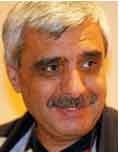| Islam and the West | |
| 08 Dec 2010, NewAgeIslam.Com |
 We have been in touch with the West for many centuries. In this era of globalization, our relations are closely intermingled, but we still give different meanings to the same thing. We are in fact like the people of the Tower of Babel. Sometimes we use the same words, with different meanings we ascribe to them. Take the word “civilization,” for example.
We have been in touch with the West for many centuries. In this era of globalization, our relations are closely intermingled, but we still give different meanings to the same thing. We are in fact like the people of the Tower of Babel. Sometimes we use the same words, with different meanings we ascribe to them. Take the word “civilization,” for example.
Medina (Medine in Turkish) originally comes from the Aramaic language. It is borrowed by Arabic. Aramaic, Arabic and Syriac languages all belong to the same language family. These three are the ancient languages of the East and, therefore, the three borrowed words and phrases from each other over time. -- ALI BULAÇ
| Medina and civilization: Muslims and Westerners still give different meanings to the same thing | |
By ALI BULAÇ We have been in touch with the West for many centuries. In this era of globalization, our relations are closely intermingled, but we still give different meanings to the same thing. We are in fact like the people of the Tower of Babel. Sometimes we use the same words, with different meanings we ascribe to them. Take the word “civilization,” for example. Medina (Medine in Turkish) originally comes from the Aramaic language. It is borrowed by Arabic. Aramaic, Arabic and Syriac languages all belong to the same language family. These three are the ancient languages of the East and, therefore, the three borrowed words and phrases from each other over time. In Aramaic, the word “medina” refers to a settlement which is under the jurisdiction of a court. Thus, it is principally used in a legal context. So, we see a word with a legal sense. The word was also known to Arabs before the advent of Islam, but rarely used then. For instance, we see that the famous Arab poet of the pre-Islamic era Hassan ibn Thabit used the word “medina” in one of his poems. But it was after the Emigration of Prophet Muhammad, peace and blessings be upon him, to Medina (known as the Hijra) that the word “medina” acquired a strong terminological use. After the Hijra, the Prophet changed the city’s name from “Yathrib” to “Medina.” Why did he do this? This is an important question. This is something that is closely linked to our vision of civilization as it allows us to establish a relationship between “religion” and “Medina.” Medina means an expression or manifestation of religion in space. Indeed, religion (din), medina, civilized (medeni) and civilization (medeniyet) are all derived from the same root. By renaming the city “Medina,” the Prophet implied that religion (Islam) will be experienced or manifested in this space, also defining the city and even the state. The Prophet first specified the limits of the city, attributing a center to the city, thereby establishing Medina. We noted above that there is a semantic link between the word “medina” and law. Thus, we can say that Medina is also law. As a matter of fact, the Charter of Medina, which can be described as the first greatest agreement in human history, was signed in Medina in 622. Thus, this charter referred to Islam as a solution for the solution of legal, epistemological and coexistence problems, and, so to speak, the city was built upon religious law. The Charter of Medina is the greatest political/legal text of a contract and allowed different ethnic and religious groups to negotiate their mutual rights and responsibilities without resorting to the use of power against each other but to coexist by concluding agreements freely among themselves. Western democracies still cannot live up to the socio-cultural pluralism of this charter. (See Ali Bulaç, “Modern Ulus Devlet” [Modern Nation-State], 4th Edition, 2007, Istanbul, p. 175 ff.) Medina is also known as “Madinat al-Nabi,” meaning “The City of the Prophet.” It is also called “Medinat al-Tayyiba,” meaning both “the Beautiful City” and the city whose food and drinks are beautiful, that is, obtained or produced through religiously permitted (halal) ways, and the “Esthetic City.” So, it follows that there should be beauty, art, esthetics, taste, law and legitimacy in Medina. Muslim scholars frequently used this word in their works. For instance, in an effort to create a synthesis between Islam and Greek philosophy, al-Farabi developed this concept in his famous book “Al Medinat al-Fadila” (The Virtuous City). He has another book titled “As-Siyasat al-Madaniyya” (Civilized Politics), which discusses urban sociology and politics. In the introduction to this book “Matla’ul-I’tiqad” (The Birth of Faith), Fuzuli says, “Man is civilized by nature.” The Qur’an, too, refers to this fact. In particular, verses 97-99 of Surah at-Tawbah, narrate how Bedouins had difficulty in adapting to city life. We know that after the Hijra, the Prophet invested efforts to ensure Bedouins adapt to urban life. Later, the second Caliph of Islam, Umar, maintained this policy. Much later, when he conquered Istanbul, Sultan Mehmed the Conqueror pursued the same policy, by bringing Muslims from Anatolia and other places to compensate for the non-Muslim population of the city as well as Armenians against the Greek population. a.bulac@todayszaman.com Source: Todayszaman.com URL: http://www.newageislam.com/NewAgeIslamIslamAndWest_1.aspx?ArticleID=3780 |




 Moderate Islamist here
Moderate Islamist here


0 comments:
Post a Comment